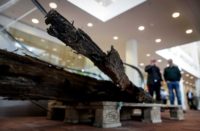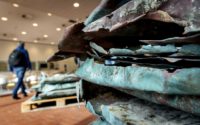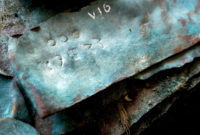On the night of January 1st-2nd of this year, MSC Zoe, one of the largest container ships in the world, lost at least 345 containers during a spate of rough weather in the North Sea. About 150 of them were lost north of the German island of Borkum, another 200 or so southwest of that near the Dutch island of Terschelling. Whole containers and some of their contents — including electronics, toys, clothing, furniture and potentially explosive organic peroxides — were found on the shores of Borkum, Terschelling and the Dutch islands Vlieland, Ameland and Schiermonnikoog.
 With so many containers and their contents, some hazardous, adrift in the ecologically sensitive coastal waters of the Frisian islands, Dutch salvage teams have been scouring the North Sea bed to clean up the debris. A salvage crew working a busy shipping lane found wood beams and copper sheets from a shipwreck and alerted authorities.
With so many containers and their contents, some hazardous, adrift in the ecologically sensitive coastal waters of the Frisian islands, Dutch salvage teams have been scouring the North Sea bed to clean up the debris. A salvage crew working a busy shipping lane found wood beams and copper sheets from a shipwreck and alerted authorities.
 The Cultural Heritage Agency of the Netherlands dispatched maritime archaeologists to investigate the shipwreck. It wreck was approximately 23 feet wide and 98 feet long when intact with a carvel-built hull. It carried a large cargo of copper plates. Analysis of the wooden beams found the timbers were felled in 1536 and the ship built no later than 1540 in the Netherlands. The copper plates bear the marks of the Fugger family, a wealthy banking dynasty from present-day southwest Germany who in the 16th century owned numerous copper mines and had the monopoly on copper production.
The Cultural Heritage Agency of the Netherlands dispatched maritime archaeologists to investigate the shipwreck. It wreck was approximately 23 feet wide and 98 feet long when intact with a carvel-built hull. It carried a large cargo of copper plates. Analysis of the wooden beams found the timbers were felled in 1536 and the ship built no later than 1540 in the Netherlands. The copper plates bear the marks of the Fugger family, a wealthy banking dynasty from present-day southwest Germany who in the 16th century owned numerous copper mines and had the monopoly on copper production.
 The ship was carrying both round and square copper plates. The round ones were up to four feet in diameter and .2 inches thick. Researchers believe they were probably used to make pots and pans. The square plates, on the other hand, were probably going to be used to make the copper coins. Chemical analysis indicates they have the same composition as the Netherlands’ first copper coins. Copper coins first came into circulation in the Netherlands in 1543. Before then only gold and silver were minted, and they were the province of the wealthy. The introduction of copper coins allowed the working and middle classes in the rising urban centers of the country to engage in the burgeoning cash economy.
The ship was carrying both round and square copper plates. The round ones were up to four feet in diameter and .2 inches thick. Researchers believe they were probably used to make pots and pans. The square plates, on the other hand, were probably going to be used to make the copper coins. Chemical analysis indicates they have the same composition as the Netherlands’ first copper coins. Copper coins first came into circulation in the Netherlands in 1543. Before then only gold and silver were minted, and they were the province of the wealthy. The introduction of copper coins allowed the working and middle classes in the rising urban centers of the country to engage in the burgeoning cash economy.
The 1540 date makes this ship the oldest sea-going vessel ever discovered in Dutch waters. It is also the oldest known caravel-built ship, which makes it a uniquely significant artifact of the shift from the small clinker-built ships of the Middle Ages to the large oceanic vessels that made the Netherlands a great maritime power.
“A lot of people think of the Dutch as a maritime nation, and this ship tells us something about how we became that nation,” said maritime and underwater archaeologist Martijn Manders.
Mr Manders said this shipwreck is of great importance because it dates back to a period where ship-building technology was in a transition from the medieval period to the Dutch Golden Age.

Archaeologists will return to the site, whose exact location is being kept under wraps for now, next summer when wind conditions and temperatures are more conducive to exploration. They hope to reveal more of the ship’s hull, much of which remains covered in sediment. The Coast Guard and Heritage Inspectorate will patrol the shipping lane in the interim to protect the wreck.
The ‘Fuggerei’ in Augsburg/ Bavaria (cf. ‘Augusta Vindelicorum’) is the world’s oldest social housing complex still in use, since it was donated in 1521 by Jakob Fugger the Younger. Copper from what is now Hungary and Slovakia was transported through Antwerp to Lisbon, and from there shipped to India (Jakob was also involved in the Portuguese fleet, their friends the Welsers, for example, were granted Little Venice, or ‘Venezuela’ as it is still referred to, in 1528).
The excavator was interviewed on the BBC, and apparently there are hopes that the Fugger-Archive in Dillingen (feel free to check out ‘fugger.de’ in the freshly invented ‘Internetz’) has detailed records on the lost ship, which apparently had been on its way to Antwerp [possibly via the Elbe river, instead of the Rhine?]. Over here, however, it had been omitted in the news reports that it had been the oldest ‘sea-going'(!) vessel, the oldest one of them all it was certainly not.
:hattip:
In contrast to my guess, Franz Karg from the “Fugger-Archive” in Dillingen argued that the ship used the Vistula river (Slov.: ‘Visla’, Germ.: ‘Weichsel’) via the Baltic Sea, and from there into the North Sea. The copper might have been sourced in what today is eastern Slovakia, but is -historically- also referred to as Upper Hungary. Falun in Sweden, as partners or competitors, was also famous for its copper mine.
They were running smelting plants e.g. in Neusohl (Lat.: Neosolium), Banská Bystrica, Hohenkirchen in Thuringia (via Szczecin) and in Tyrol, and then shipped the copper to their Antwerp premises (which Albrecht Dürer mentions in his diary, obviously he was having several meals with staff members in Antwerp, e.g.: ‘..the same evening the Fugger’s factor, by name Bernhard Stecher, invited me and gave us a costly meal’).
By the way, there were –at least– two more shipwrecks with Fugger trading goods and copper found in Africa. In 2008, the Portuguese vessel “Bom Jesus” that sank 1533 in Namibia, and in 2012 the “Ngomeni-Shipwreck“ near Malindi in Kenia. Apparently, the stuff was not only traded against spices, but also against human cargo, and there is a slave market in Lagos (i.e. here, the one in Algarve in Portugal).
Dürer sketched the “Antwerp harbor” (unsure, if there was more than one harbor), and even 20 years earlier, the Fuggers and the Portuguese were apparently rather close to each other in Antwerp, as he dined with both.
:hattip:
—————–
“…I visited Fugger’s premises in Antwerp [in 1520, roughly 29 years earlier], which is newly built, with a wonderful tower, broad and high, and with a beautiful garden, and I also saw his fine stallions. Tomasin has given my wife fourteen ells of good thick arras for a mantle and three and a half ells of half satin to line it. I drew a design for a lady’s forehead band for the goldsmith. The Portuguese factor has given me a present of wine in the inn, both Portuguese and French. Signor Rodrigo of Portugal has given me a small cask full of all sorts of sweetmeats, amongst them […] some sugar-canes just as they grow; I gave his servant in return 1 florin as a tip. I have again changed for my expenses a light florin for 12 stivers. …”
—————–
I never know which I enjoy more (or learn more from), the Blog or the comments. Enjoy them Both!